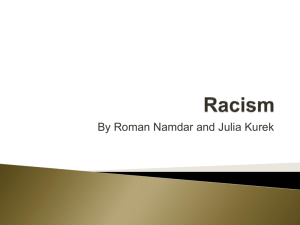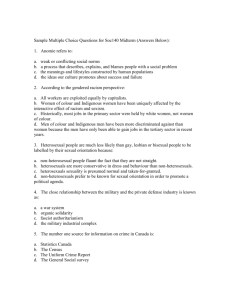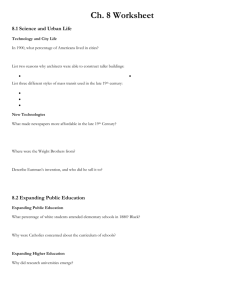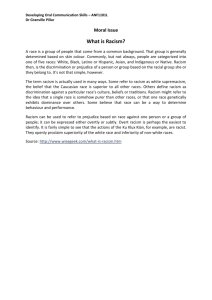Racism and education outcomes of Aboriginal and Torres Strait
advertisement
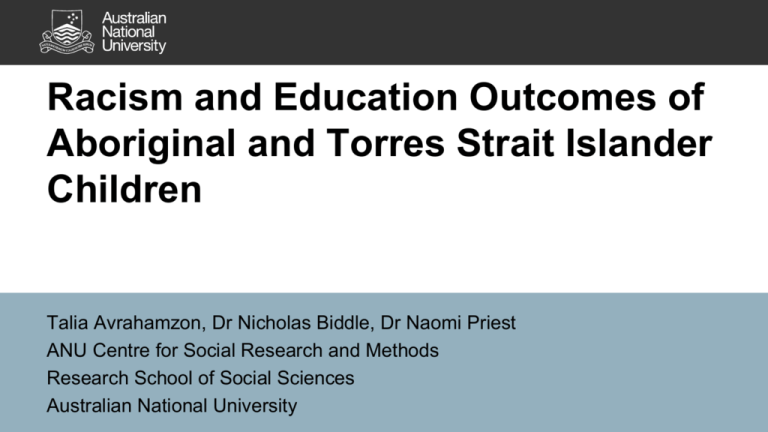
Racism and Education Outcomes of Aboriginal and Torres Strait Islander Children Talia Avrahamzon, Dr Nicholas Biddle, Dr Naomi Priest ANU Centre for Social Research and Methods Research School of Social Sciences Australian National University Background • Education disparities persist between Indigenous and nonIndigenous Australians • Australian Government Indigenous Affairs priorities on education • Racism - impact on education, health and wellbeing 2 What is racism? • An organised system of oppression founded on the social categorisation and stratification of social groups into ‘races’ that devalues and disempowers groups considered to be inferior and differentially allocates to them valued opportunities and resources • Three distinct, but interrelated, levels: – Internalised – Interpersonal – Systemic or structural • Commonly expressed as prejudice (negative attitudes), stereotypes (categorical beliefs) and discrimination (unequal treatment) (Williams 2004) Racism and Education, Health and Wellbeing • • • • Racism operates through multiple mechanisms Institutional and cultural racism can adversely affect health and education through stigma, stereotypes, prejudice and racial discrimination Differential access to SES and to a societal resources and opportunities Impact on both the stigmatised and non-stigmatised Children particularly vulnerable to racism’s harmful effects Direct effects • anxiety, depression, behaviour problems, substance use, immune and inflammatory biomarkers Indirect/Vicarious effects • pregnancy and birth outcomes, childhood illnesses, mental health • mediated via carer mental health, parenting style, ethnic-racial socialisation, access to resources for health e.g. healthcare, housing Priest N et al. (2013) A systematic review of studies examining the relationship between reported racism and health and wellbeing for children and young people. Social Science and Medicine. 4 Racism and Education Outcomes • The school itself is the most common place children experience racism and racial discrimination • Racism associated negatively with attendance, standardised maths and spelling scores • Children whose carers felt they were discriminated against because of their Indigenous status [were] significantly less likely to be attending preschool • Students’ acceptance and ‘own’ the negative stereotypes 5 Education Outcomes – Australian Government priorities • Four of the eight Closing the Gap targets are education focussed • 2014 & 2015 CtG Reports one of three priorities: getting children to school: [A]ny work in these priority areas must be underpinned by improving the health and wellbeing of individuals, families and communities. • National Aboriginal and Torres Strait Islander Health Plan (NATSIH) 2013-23 - racism is acknowledged as a “key social determinant of health for Aboriginal and Torres Strait Islander people”. • Narragunnawali: Reconciliation in Schools and Early Learning, Reconciliation Australia • 18 September 2015: Changes to the National Curriculum – schools no longer required to teach about Reconciliation Action Week, NAIDOC Week, Harmony Day. Greater focus on Western civilisation. 6 Study Aims • Is there an association between carer assessed experiences of racism and racial discrimination and a child’s academic self-concept, literacy and numeracy skills, subjective wellbeing and absenteeism? • Is there an association between carer and / or family experiences of racism and a child’s academic selfconcept, literacy skills, numeracy skills, and absenteeism? Methods and data • Data – Longitudinal Study of Indigenous Children • Kid cohort (up to 591 children) • • Experience of discrimination measured in Wave 3, 4 and 5 (Aged 5-9) Outcomes measured in Wave 6 (Children aged 8-10) • Carer report of discrimination • • • • As far as you know, has (STUDY CHILD) been bullied or treated unfairly at preschool / school because (he / she) is Aboriginal or Torres Strait Islander? How often does your family experience racism, discrimination or prejudice Seven outcomes (mean = 0, s.d. = 1) • • • Child reports (self perception, wellbeing at school, cultural identity) Teacher reports (attendance rate) Assessment scales (maths and reading) • Parent reports (Strengths and Difficulties Questionnaire) Two models for each dependent variable • Model 1 – Discrimination only; Model 2 – Discrimination and gender, age, remoteness, carer education, household finances and mobility. 8 Results (I) – Experience of discrimination Family experience Wave 3 Wave 5 Every day 2% 2% Every week 2% 2% Sometimes 10% Child experience Wave 4 Bullied 6% Treated unfairly 1% Both 1% 14% Occasionally 15% 15% Never or hardly ever 72% 67% Neither 93% 9 Results (II) – Effect of discrimination Difference in index between those who have and have not experienced discrimination 0.1 0.05 0 -0.05 -0.1 -0.15 -0.2 -0.25 Model 1 -0.3 Model 2 -0.35 -0.4 Self Subjective perception wellbeing at school Cultural identity Maths Reading Strengths Attendance and in current Difficulties school year 10 Future work Data limitations • What is the context of the racism? • Children’s experience? • Who are the stigmatised and who are the non-stigmatised? • Ethnic-racial socialisation messages and approaches to support positive racial/ethnic attitudes, beliefs and behaviours and to counter bias and prejudice – Need for response for both stigmatised and non-stigmatised – Schools that offer teaching of Indigenous history and culture, and Indigenous language has positive impact on attendance of Indigenous children 11 Talia.Avrahamzon@anu.edu.au Nicholas.biddle@anu.edu.au Naomi.priest@anu.edu.au 12
